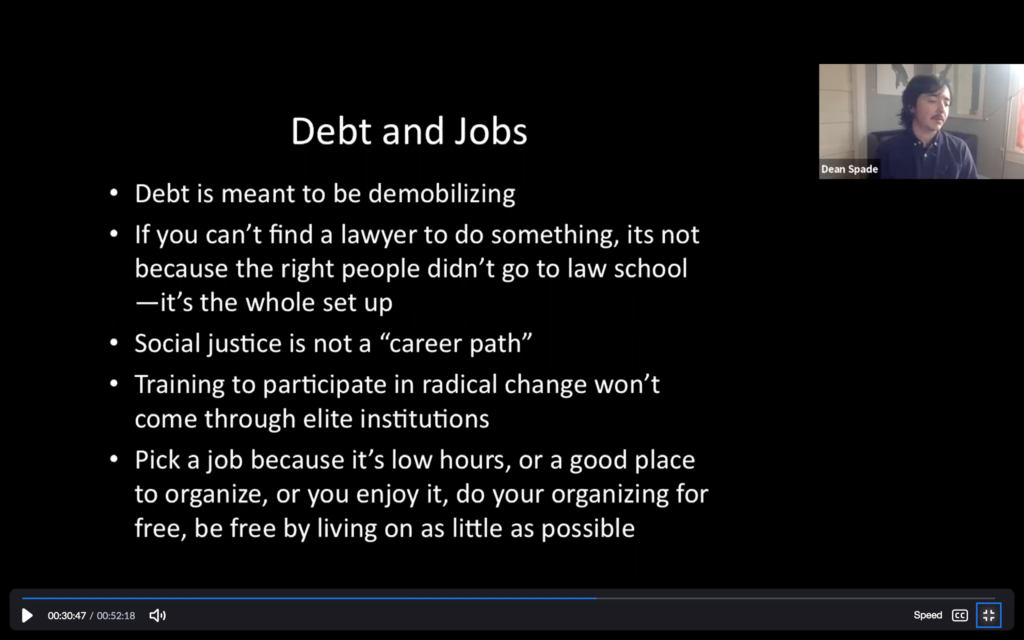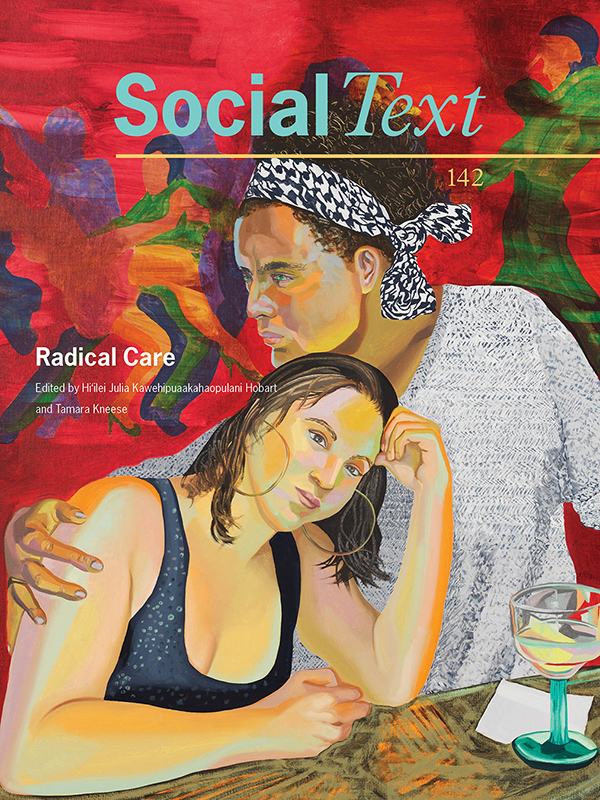This conversation was very rich and useful for me. I hope you enjoy it! I am grateful to the organizers and my fellow panelists.
Video of Conversation about Pinkwashing and Solidarity with WWU’s SUPER Chapter
For Israeli Apartheid week, I joined the SUPER chapter at Western Washington University and gave a talk on pinkwashing and how it emerged from a rights-based gay liberal inclusion politics, and what it looks like to resist that politics and center racial and economic justice in queer and trans liberation work. The first two minutes have some strange audio so I recommend skipping to 2:00 and diving in from there.
Videos of a Rad Conversation
I learned so much at this event, which pulled together a group of brilliant organizers to talk about mutual aid, debt and labor strikes, and more. The first video below was a conversation featuring a bunch of speakers giving short, info-packed presentations, and the videos after that are moderated break out room conversations. I gave a presentation in the first event and was one of the speakers in the mutual aid break out room, which I really enjoyed, but I recommend you watch them all!
New Video: Conversation with Dream Defenders, Ujimaa Medics, Mariame Kaba, and Dylan Rodriguez about Mutual aid
“Mutual Aid” is a People’s Movement: Beyond Philanthropy, Charity, and Dependence on the (Police) State
An American Studies Association 2020 Freedom Course recorded on April 22, 2020
Framing questions: * What is “mutual aid,” and how is it different from charity, philanthropy, and state social services? * How is mutual aid part of current and historical freedom, liberation, and self-determination struggles of different peoples? * How are mutual aid efforts responding to the COVID-19 pandemic? * How can people participate in mutual aid projects RIGHT NOW?
Participants: * Rachel Gilmer, Helen Peña, and Dr. Armen Henderson Dream Defenders (https://dreamdefenders.org/) * Amika Tendaji Ujimaa Medics (https://umedics.org/) * Mariame Kaba Project NIA (http://project-nia.org/) * Dean Spade Seattle University School of Law (http://bigdoorbrigade.com/) * facilitated by Dylan Rodríguez Univ of California, Riverside; President-Elect of the American Studies Association (2020-2021)
What Every Activist Should Know Before Going to Law School
About ten years ago I published this short essay in the lefty law journal Unbound about the myths that mislead a lot of people who want social change to think they should go to law school, and the realities people should know before going. This week, Patricia Sully from the University of Washington’s Legal Pathways program hosted a webinar on the topic where I shared some of these ideas and people asked some great questions. Here is a captioned video recording of the session.

Discussing this with some other people led me to learn about this amazing clip which I also recommend you incorporate into your deliberations about law school:
Mad Maps for the Pandemic
This is a difficult time, and most of us are under enormous pressure. We might be experiencing isolation, illness, income loss, fear for loved ones, loss of loved ones, anxiety, and many other painful circumstances. A mad map is a guide we can make for ourselves, usually best worked on in moments were we are feeling more centered or having more capacity, that we can turn to in moments where things go sideways or we feel ourselves slipping into more difficult states. A mad map can be like a little gift of preparation for a future self who is going into potentially dangerous waters. Your mad map could have any areas or categories, could be illustrated or include songs or physical movements. Below are just some starter ideas and examples of potential content. Change all the language and content as you want so it is meaningful to you. It could also be made as a collage, a song, a zine, or in whatever way is best for you. Some people share their mad maps with friends and loved ones. You could include sections on how other people can support you when you are in difficulty or crisis, and what you do not want them to say or do if you are in crisis.
I learned about mad maps first in an Icarus Project workshop, and later read this zine. You might also listen to this podcast episode and check out this worksheet that was distributed with the podcast.
Signs of Off-Center Thinking, Feeling, and Action
What are you noticing you are thinking, feeling, and/or doing that feels sideways? Some areas to think about when making this section might include:
- Obsessively checking for news or information related to the pandemic
- Obsessively checking myself for signs or symptoms of COVID-19
- Over-working on anything (house cleaning, paid job, activist work, etc.)
- Letting the physical space around me get chaotic
- Not eating or eating in ways that make me feel bad
- Not taking meds or supplements that are helpful to me regularly
- Misusing alcohol, drugs, shopping
- Misusing video games, TV, social media
- Avoiding people I love
- Short-tempered, explosive, or over-critical with loved ones
- Avoiding work that is meaningful to me
- Avoiding work I need to do to survive
- Not taking care of bills, paperwork, unemployment applications or other logistics necessities
- Escalating with a date or otherwise escaping through sex or romance highs
- Any other compulsive behavior that feels imbalanced right now
- Lack of sleep or oversleeping
- Over exercising or not moving enough for what my body/mind needs right now
Guidelines for Greater Wellness
In this section, try set realistic expectations, not pie in the sky guidelines that will cause shame or feelings of inadequacy if they are not met. You can always increase and adjust later. Be aware of harsh “should” messages that may show up here, which many of us have in areas of eating, work, exercise, money, etc. Focus on gentle realistic steps toward greater wellness, mindful of perfectionism.
This section might include things like:
- Limit of number of times per day I check news, research information about the pandemic, or look up symptoms online
- Limits on amounts or times of day I do particular escapist or toxifying behaviors
- How often and in what ways I want to move my body
- Goals for making sure I feed myself in nourishing ways
- Goals for meditation, spiritual practices, or anything else that would help but might be falling out right now
- Types of media I want to avoid, might include deleting certain apps
- Limits on amount of or times of using social media (like not upon waking or before bed, for example)
- Goals (if appropriate for your situation) for getting outdoors or interacting with plants, animals, etc.
- People I want to be connected to, how often and in what ways
- People I need to limit my exposure to and what limits
- Sleep schedules or other rest plans
- Limits on working hours, creation day(s) off or other limits on work, including unpaid activist or artistic work if I am overworking in those areas
- Timelines for taking care of essential paperwork or logistics
- Baseline activities to maintain your physical space and hygiene
Bonus Activities that Help
If the prior section is baseline guidance that you are committing to, this section can have things you might aspire to do, things you know would feel good, things that are lovely extras.
- Kinds of movement or exercise that are fun and feel good
- Cooking adventures
- Gardening
- Music, art, literature I want to listen to, watch, look at, read
- Music or art I want to make
- Spiritual practices I want to try or return to
- Additional ways I want to connect with loved ones
- Additional activities that might boost my mood or sense of purpose, connection, or self-worth
- Ways to beautify my space
- Ways I want to be generous to others
- Things I want to try to improve my sleep, reduce my pain, break my isolation, generate a more structured routine, break up a monotonous routine
- Quality time with certain people or animals
Unhelpful/Untrue Thoughts
Painful or difficult distorted thinking increases when we are under pressure. Often it will be familiar thinking that has appeared in other difficult times. Often it feeds behaviors that are bad for us and disconnect us from ourselves and others. Noticing it can give us a chance to interrupt it and see if it can be reduced. Here are some types of distorted thinking that may be coming up, or you can fill this section with whatever is true for you.
- Scarcity thoughts (about anything—food, money, work, self-worth, sex, health, etc.) like:
- I’m not doing enough.
- I’m doing everything and no one is helping.
- I’m not going to have what I need.
- I better get mine before everyone else takes it all.
- Hopeless thoughts like:
- There is no point in trying.
- I have lost everything.
- I ruined everything.
- Nothing every works out for me/us.
- Shame/self-hating thoughts like:
- I’m a fraud.
- I am undesirable.
- I am the worst.
- I don’t deserve help/care/support/love/admiration/survival.
- I am a bad person.
- Superiority thoughts like:
- No one else can do this right.
- No one else can see the truth like I can.
- Everyone else is handling this incorrectly.
- Any criticism or feedback about my behavior is incorrect/inappropriate.
- Hypervigilant thoughts like:
- I better check [the news, my loved ones well-being, my bank account, my body, my symptoms, my food, others’ opinions of me, social media, or anything] again and again.
Helpful Truths to Remember
In this section, call on your most centered self, your inner adult, your inner kind parent, your highest spiritual self or however you think of that part of you that has loving and compassionate perspective. Go through the distorted thoughts above and list what the part of you thinking each thought needs to hear or remember to diffuse the power of that thought a bit. The examples below may help you generate your list.
- Everyone is having a hard time right now. It is okay that I am not functioning “as usual.” I can cut myself some slack.
- Even if I feel alone, I am not alone. There are many people experiencing what I am experiencing. There are people who care about me.
- It is okay to be distracted and disoriented right now, and to feel dissatisfied. I don’t have to try to solve those feelings. I can try to be compassionate with myself about them, and also try not to act out of them in ways that hurt myself.
- There is nothing I have to do, and all that I choose to do will be better for me and others if it doesn’t come from this “must” and “should” feeling, but instead from sober discernment of how I can care for myself and others.
- This is a precious time to connect with loved ones give them my attention. I can do this from a place of desire, not a place of inadequacy.
- It is okay for me to place limits on what I can do for others and say no to things that don’t work for me. Everyone deserves to exist, including me.
- I don’t have to do anything perfectly.
- It is okay to try new things. I can stop whenever I want.

In case it’s useful to read my mad map, here’s what I have so far.
Dean’s Mad Map for the Pandemic
Off-center feelings/experiences/behaviors:
- Checking the news too much/consuming too much info about pandemic
- Distractedness and difficulty staying on one task
- Perfectionism about tasks (mostly related to activist work)
- Irritation/impatience during meetings
- Critical thoughts/comments about myself and others
- Sense of scarcity about time to work
- Avoidance of certain people who know me well who, if I talked to them, I might feel more of my feelings or be held accountable about caring for myself
- Obsessive thinking about tasks, including at night and upon waking
- Craving escapist activities/judging that craving/over-regulating escapist activities
Guidelines for Greater Wellness:
- Only listen to news once a day, and at most one additional podcast related to pandemic
- Meditate every day at least 20 minutes
- Physical therapy exercises every morning
- Walk outside every day, at least 3 times a week a walk more than 2 miles
- Yoga or weights at least 3 times a week
- Time set aside to talk to CB when we aren’t doing anything else
- Centering practice 1-5 times/day with connection to feeling of purpose
Bonus Activities That Help:
- Board games or cards with family members
- Listen to music instead of podcasts
- Put on a fun outfit and go for a walk
- Phone date with CW
- Longer meditations
- Bring in flowers from outside
- Snail mail & crafting
Unhelpful/Untrue Thoughts:
- I’m not doing enough (activist projects, self-care, writing, correspondence with loved ones).
- I’m a bad friend, boyfriend, caretaker of dogs, uncle, sibling, nephew, etc.
Helpful Truths to Remember:
- My conditioning makes me want to respond to the unknown of this time with over-doing. There is nothing I have to do, and all that I do will be better for me and others if it doesn’t come from this “must” and “should” feeling, but instead from choice and sober discernment of how I can be of service.
- This is a precious time to be connected to the people and animals I live with and give them my attention. I can do this from a place of desire, not a place of inadequacy.
- I benefit from my self-care practices and I can notice feelings of avoidance but remember and choose the benefits instead.
- I don’t have to do anything perfectly. No need to use self-care practices as a space to feel inadequate.
Areas Where I Want to Build More Boundaries or Guidelines:
- Start/end times for working
- Focusing on one task at a time, e.g. turning of internet when writing, answering email during a distinct block separate from looking at social media or other tasks
Mutual Aid Disaster Relief Interview!
Roberto Sirvent and I are publishing a series of interviews with mutual aid groups in Black Agenda Report. Check out the second in the series, with Mutual Aid Disaster Relief!

Read My Book and Lots of Other Stuff for Free!
Duke University Press just published a Care for Uncertain Times syllabus making tons of great work free to read! I am so grateful that my book, Normal Life: Administrative Violence, Critical Trans Politics and the Limits of Law is included, as is the new issue of Social Text on Radical Care in which I published an article on mutual aid. Check it out!

Ujimaa Medics Interview on Mutual Aid
Roberto Sirvent and I are working on a series of interviews with rad mutual aid organizations and practitioners for Black Agenda Report. The first interview, with Ujimaa Medics, is now out! Have a read and look out for more to come.

Democracy Now! Segment on Mutual Aid
I had the great pleasure of appearing on Democracy Now! today with my favorite thinker/talker/doer, Mariame Kaba, to talk about the growing network of mutual aid projects and pods responding to COVID-19, and the broader context of mutual aid in left social movements.